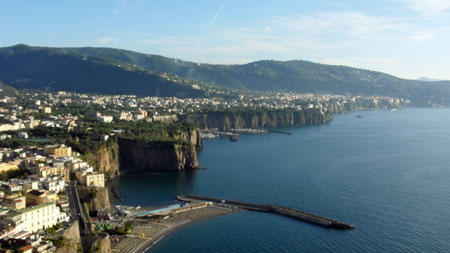
The waiter at the place we stayed in Rome runs a side business of taking guests on side trips or to their next destination. We decided to use his services instead of taking a train to Sorrento. It was much more convenient, we skipped the hour long train ride to Naples and the train ride from Naples and Sorrento, also we got to stop for a two hour lunch and we made several site seeing stops along the way. Plus we got left off at the front door of our hotel in Sorrento which was a couple of blocks from the train station…
Trains are an excellent way of traveling in Italy. We used the train from Sorrento to go to Pompeii and Naples. One suggestion is if you are traveling a long way on a train; go first class, much more comfortable and quieter, as Italians seem to be in the habit or getting into arguments on trains.
While we were in Sorrento (a very touristy town), we found a great family run restaurant down by the tranquil Marina Grande called Trattoria da Emilia. Wonderful fresh fried fish, heads included, we found a cat to feed those to. Lots of locals, which is always a good sign. It was quite a walk back in the dark though!
The next day we went to Pompeii and then (a smaller less known site also covered by the Mount Vesuvius explosion in A.D. 79, smaller, but in much better shape than Pompeii, because while Pompeii was covered with 30 feet of hot volcanic ash and pumice, Herculaneum was instead covered in 60 feet of hot, boiling mud, which baked into “tuff” rock, perfectly preserving the whole city. Also it wasn’t raided as early as Pompeii, due to the difficulty of exploration.
httpv://www.youtube.com/watch?v=1yDo6-2Odr0
Anyway back to Pompeii, it used to be on the sea coast, the first picture is the site where they tied up the boats, now it is a LONG way to the current sea coast, thanks to Vesuvius. And it is Huge, I never thought it would be so big, and there are still parts that haven’t been uncovered. 20,000 people were living there, but only 2,000 died in the ash that August 24, 79 A.D. I guess they were the ones that didn’t heed the emergency services warning! Joke. Our video tells the tale.
Notice the Fast Food Joints in both cities. Apparently Romans (except the rich ones) did most of their eating out. The round tops lead down into a huge ceramic vase, which held olives, wine, soup and other foods of the day. (Judy had no idea how they could clean them out, no drains, so you could imagine the quality of the food… they must have had strong stomachs!
You can clearly see the chariot tracks in Pompeii, on the original roads, and tell by the number of stones in the road whether it was one way, two ways, a major thoroughfare or pedestrians only.
Herculaneum also was a sea front, most of the people found died while crouching under the arched docks which once held the boats. (I guess the first comers got away on them.) You can see in the pictures the high cliffs, with the modern town on top to see how much excavation had to be done to find the city.
This was a big day, with lots of walking. We were exhausted… more to come.